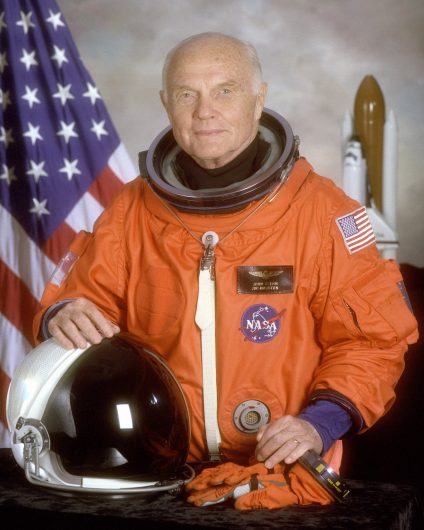
Portrait of John Glenn before making his return to space at the age of 77 as a payload specialist aboard the Space Shuttle Discovery in 1998. Credit: Courtesy of NASA
John Glenn, the first U.S. astronaut to orbit Earth, has taken his rest in the heavens.
Glenn died in Columbus on Thursday at age 95, Ohio State confirmed.
“John Glenn is, and always will be, Ohio’s ultimate hometown hero, and his passing today is an occasion for all of us to grieve,” Ohio Governor John Kasich said in a release.
On the books, Glenn was many things: a World War II pilot, a Korean War pilot, a colonel in the U.S. Marine Corps, an astronaut, a U.S. senator, an astronaut again, a lifelong champion of civic engagement, a doting husband.
On the campus of Ohio State, he was all of those things, as well as a Buckeye.
“The Ohio State University community deeply mourns the loss of John Glenn, Ohio’s consummate public servant and a true American hero. He leaves an undiminished legacy as one of the great people of our time,” University President Michael Drake said in a statement.
On OSU’s campus, his and his wife’s names lead students down what was West 17th Avenue, and his legacy is hoped to lead students of the John Glenn College of Public Affairs even further.
“If this cynicism and apathy is allowed to continue to fester, it will not only be dangerous, in our democracy it will be suicidal,” Glenn said in 1998, according to OSU, with the announcement of the John Glenn Institute for Public Service and Public Policy, a forerunner to the Glenn College. “I honestly believe that through this institute, the Ohio State University can be an instrumental part in rekindling the nation’s commitment to public service.”
Glenn’s public service spanned nearly six decades and, in his retirement, he made a full-time job of advocating the value of public service.
Glenn was thrust into national consciousness when he became the first American to orbit the Earth, piloting Friendship 7 on February 20, 1962. Manning the Mercury-Atlas 6 mission made him the third human to complete an orbital journey, after Soviet cosmonauts Yuri Gagarin and Gherman Titov, as well as the third American in space, after fellow Mercury Seven astronauts Alan Shepard and Gus Grissom.
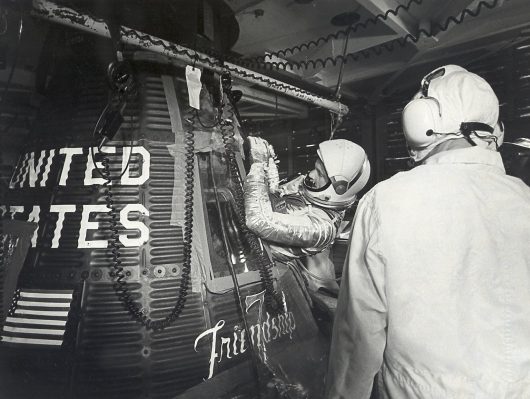
John Glenn enters the Mercury spacecraft, Friendship 7, before launch on February 20, 1962. Credit: Courtesy of NASA/Marshall Space Flight Center
Glenn circled the Earth three times in four hours, 55 minutes, and 23 seconds, according to NASA. But the mission was not without complication, and Glenn’s expertise as a pilot and familiarity with the capsule would be put to the test. During orbit, Friendship 7’s automatic control system didn’t function as planned, forcing Glenn to man the ship through the last two orbits, as well as re-entry. Adding to that, Glenn had to descend without firing the ship’s retro rockets in order to keep in place what was believed to be a loose heat shield, the ship’s safeguard against the deadly temperatures reached during high-speed atmospheric re-entry.
Upon climbing out of the Friendship 7 capsule that had been hoisted onto a destroyer from waters about 720 miles southeast of Cape Canaveral, Fla., Glenn reportedly grinned, remarked, “It was hot in there,” and then grabbed an iced tea, according to the New York Times.
Three days later, President John F. Kennedy awarded Glenn the NASA Distinguished Service Medal at Cape Canaveral, Fla. A week later, his return was celebrated with a ticker-tape parade in New York City, in which 3,474 tons of confetti flew — a record, second only to the VJ Day celebration marking the end of World War II, according to The Times.
Before rising to fame as an astronaut, Glenn had signed on with the U.S. Army Air Corps during World War II. After his orders failed to come through, he got anxious. He enlisted in the Naval Aviation Cadet Program in March 1943 and completed flight training, before transferring to the U.S. Marine Corps, according to NASA. He piloted an F4U Corsair fighter aircraft and flew 59 combat missions during the WWII Pacific campaign.
During the Korean War, Glenn flew another 90 combat missions, going on 63 missions in F9F Panther fighter jets with the Marine Fighter Squadron, then 27 more in F-86F Sabre fighter jets.
For his service, Glenn was awarded the Distinguished Flying Cross on six occasions, as well as the Air Medal, with 18 clusters.
After Korea, Glenn returned again to the Navy, this time to test newly developed fighter jets at the Navy Test Pilot School in Maryland. And from 1956 to 1959, he pushed Naval and Marine jets to their limits at the Fighter Design Branch of the Navy Bureau of Aeronautics in Washington D.C.
Glenn set the record for fastest transcontinental flight in 1957 when he darted from Los Angeles to New York in the three hours, 23 minutes and 8.4 seconds as the first pilot to average supersonic speeds during such a flight.
In June, Columbus honored his hand in steering the history of flight, renaming the capital city’s international airport the John Glenn International Airport. The NASA John H. Glenn Research Center at Lewis Field in Cleveland is also named in his honor.
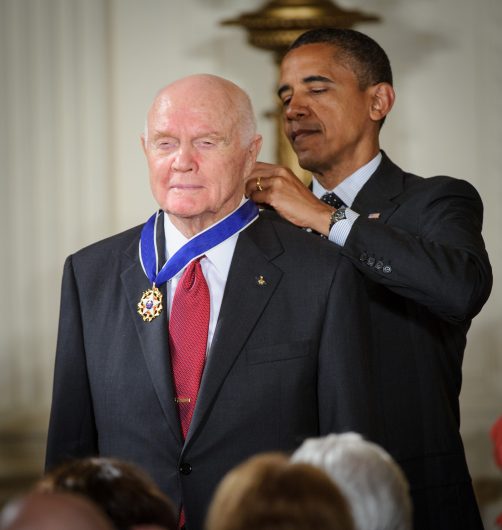
President Barack Obama presents John Glenn with a Medal of Freedom on May 29, 2012, during a ceremony at the White House in Washington D.C. Credit: Courtesy of NASA
In 2012, he was awarded the Presidential Medal of Freedom by President Barack Obama. Glenn was bestowed the nation’s highest civilian honor alongside author and Nobel laureate Toni Morrison, singer-songwriter and now-fellow laureate Bob Dylan, and the first female secretary of state, Madeleine Albright.
“On the morning John Glenn blasted off, into space, America stood still,” Obama said during the ceremony. “And for half an hour, the phones stopped ringing in Chicago police headquarters. New York subway drivers offered a play-by-play account over the loudspeakers. President Kennedy interrupted a breakfast with Congressional leaders and joined 100 million TV viewers to hear the famous words, ‘Godspeed, John Glenn.’”
And when Friendship 7 made splashdown, Glenn became, in the eyes of a nation, a hero “in every sense of the word,” the president said.
But Glenn’s service to his country was far from over.
Glenn announced his candidacy as a Democrat for U.S. Senate on Jan. 17, 1964, just one day after resigning from NASA. Doctors, however, persuaded him to withdraw from the race that March after an accident in his Columbus apartment, in which Glenn sustained a concussion that affected his inner-ear balance, according to NASA.
In 1965, Glenn retired from the U.S. Marines a colonel, and entered the private sector to serve as vice president of Royal Crown Cola in Fort Lauderdale, Fla. He would eventually become president of the corporation, and remained with it until 1970.
He was elected senator to the 94th Congress in November 1974, two decades after dropping out of his first run, and after narrowly losing the Democratic primary for a Senate run in 1970. He served four consecutive terms, until 1999.
In his time as senator, he served on the Committee on Governmental Affairs from 1987 to 1995. Glenn worked to strengthen domestic and international affairs in his time serving on Armed Services and Foreign Affairs committees. He also served on the Select Committee on Intelligence and Special Committee on Aging.
He made a brief bid for the Democratic presidential nomination in 1983 but dropped out the next year after not winning early primaries.
At the onset of the savings-and-loan crisis, in the late ‘80s, Glenn and four other senators were caught in a corruption scandal regarding an investigation into the Lincoln Savings and Loan Association and chairman Charles H. Keating, Jr. Of the dubbed “Keating Five,” Glenn and Sen. John McCain were cleared of charges by the Senate Ethics Committee.
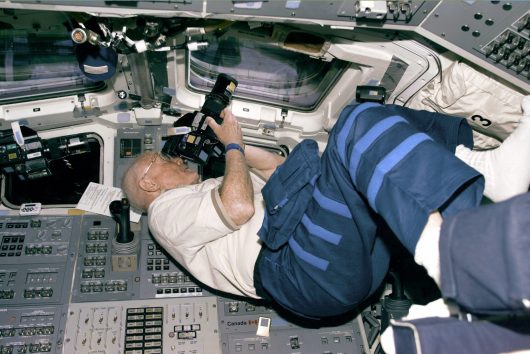
Payload Specialist John Glenn takes photos from a Discovery flight deck window on his third day of flight. Credit: Courtesy of NASA
In 1998, Glenn, at the age of 77, returned to space as a payload specialist aboard the Space Shuttle Discovery.
That year, OSU announced the formation of the John Glenn Institute for Public Service and Public Policy. Glenn donated his archives, documenting his journey from the military to the Senate. The institute formed into the John Glenn School of Public Affairs in 2006, and then into a college in 2015.
U.S. Sens. Rob Portman, a Republican, and Sherrod Brown, a Democrat, both of Ohio, spoke of the influence Glenn had on their careers in public service during a ribbon-cutting ceremony for the college in April 2015. Both senators serve as Board of Advisors at Glenn College.
“On my wall in my office in the Senate in Washington, I have a picture of me with John Glenn in 1969, and I have a picture with John Glenn standing by the Ohio clock outside the Senate right after he had walked me down the aisle for the swearing in of my first Senate term,” Brown told The Lantern in 2015. “Those two pictures are side by side and I, obviously, treasure them.”
John was born July 18, 1921 in a home on Foster Avenue in Cambridge, Ohio, located about 9 miles east of New Concord in eastern Ohio. After high school, he attended Muskingum College and received a Bachelor of Science in engineering in 1962. Glenn was the OSU Spring Commencement speaker in 1984 and 2009. He has received numerous honorary degrees from multiple universities.
Glenn is survived by his co-pilot in life and wife of 73 years, Annie Glenn.
Annie and John Glenn met in New Concord, Ohio, as toddlers, according to his autobiography, “John Glenn: A Memoir.” The two even shared a playpen at their parents’ dinner parties.
“She was part of my life from the time of my first memory,” he wrote.
According to the John and Annie Glenn Historic Site, John said he couldn’t remember the first time he told Annie he loved her, or the first time she told him. But it didn’t matter. They already knew. Annie and John were married at College Drive Presbyterian Church, in New Concord, on April 6, 1943.
Annie holds an honorary doctorate in public service from OSU. The “Annie” award has been presented annually by the American Speech-Language-Hearing Association to individuals dedicated to building public awareness on behalf of those with communication disorders.
At the ribbon-cutting ceremony for the John Glenn College, Portman said to warm laughter that although John might be the hero, everyone came to see Annie, adding their marriage served as a model for him and his wife, Jane.
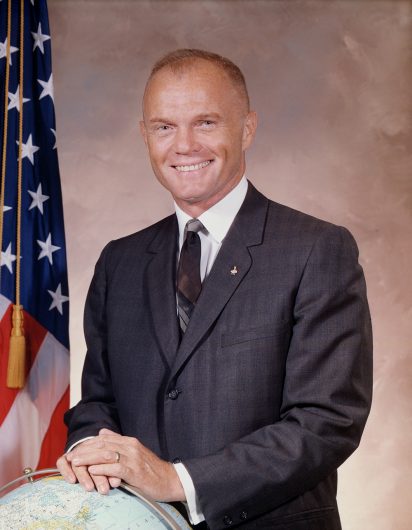
John Glenn portrait originally published in 1964. Credit: Courtesy of NASA
“These young people inspired me, just as John Glenn has inspired me, by his commitment to this enterprise,” Portman said of his time on the advisory board. “His extraordinary career is exactly what he wants all these students to have a shot at. They’re not going to be astronauts, probably, but they have the opportunity to serve their neighbors. And that is the ultimate honor.”
The mission to inspire citizenship and develop leadership is one gladly taken by the college that bears Glenn’s name, Drake said at the ceremony.
“It carries on Sen. Glenn’s legacy, honoring his work as a prominent figure in our nation’s history with an impressive record of dedicated citizen leadership. John and Annie Glenn not only embody what it means to be Buckeyes, they embody what it means to be exemplary human beings,” Drake said.
“This leading public affairs institution will continue to prepare tomorrow’s public leaders as they follow in the footsteps of a true American hero.”
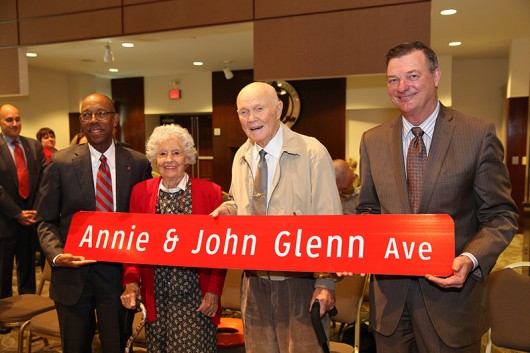
President Michael Drake, Annie Glenn, John Glenn, Board of Trustees Chair Jeffrey Wadsworth pose with the street sign for the newly named avenue on OSU campus. Credit: Courtesy of OSU
This article was updated at 4:45 p.m. to include a statement from Ohio Governor John Kasich.


